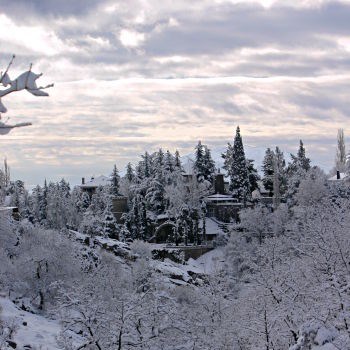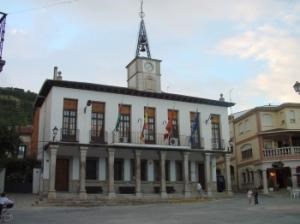[ENGLISH VERSION BELOW]
 El propósito de este cache es que conozcais la localidad madrileña de Miraflores de la Sierra.
El propósito de este cache es que conozcais la localidad madrileña de Miraflores de la Sierra.
El caché original fue creado en 2009 por el equipo Alfonso y Rosa, por el cariño que tiene Rosa a este pueblo serrano, donde pasó los veranos de su infancia y adolescencia. En 2016 Alfonso y Rosa dejaron el geocaching y archivaron sus cachés. Entonces adoptamos el caché con especial afecto ya que, además del cariño a Miraflores que compartimos con Rosa, fue el primer geocaché que buscamos cuando empezamos en este juego. El caché se mantiene casi idéntico al original.
Os proponemos un recorrido a pie por alguno de los puntos principales del pueblo donde teneis que recabar la información necesaria para resolver las coordenadas finales. El último punto con pistas asi como el cache final se encuentran fuera del casco urbano, y son fácilmente accesibles en coche. Pero sinceramente os recomendamos que esta última parte también la hagais andando; es un paseo de aproximadamente una hora y media (en total contando ida y vuelta) desde que salís del centro del pueblo, pasando primero entre casas veraniegas del siglo XIX y despues con buenas vistas al valle y las montañas.
Respecto al aparcamiento, siento decir que es difícil en fin de semana, sobre todo si hace buen tiempo, ya que las calles son estrechas y mucha gente se acerca a tomar el aperitivo en las soleadas terrazas de la calle principal.
Bueno, esperamos que os guste y que disfrutéis del pueblo y paisaje.
Antes de entrar en materia de geocaching, aqui teneis algunos datos del pueblo para situaros en contexto:
Miraflores de la Sierra se encuentra en un enclave privilegiado de la Sierra de Guadarrama, a 49 km de Madrid. Está situada en un pequeño valle, en el cruce de caminos hacia los puertos de La Morcuera y Canencia y rodeada del más extenso melojar de la Comunidad de Madrid .
Porquerizas fue el anterior nombre de esta población, cuyo origen data del reinado de Alfonso X el Sabio, si bien se desconoce la fecha exacta. La leyenda atribuye el cambio de nombre a doña Isabel de Borbón, esposa de Felipe IV, que al transitar por la cima de la Raya camino del monasterio de Paular, observó el pueblo durante la espléndida primavera y exclamó al ver la vegetación: ¡Mira, flores!
Por la belleza de sus paisajes se fue configurando como foco turístico desde finales del siglo XIX, construyéndose muchas villas de recreo aristocráticas. El premio nobel de literatura Vicente Aleixandre fue veraneante en este pueblo y le dedicó varios poemas.
Desde Miraflores se pueden realizar varias rutas de senderismo por la sierra. Para mas información podeis acudir a la oficina de información turística que se encuentra a la entrada del pueblo o visitar su página web www.mirafloresdelasierra.org.
Descripción del cache:
Iglesia (N 40º 48.823', W 3º 45.926')
En su puerta principal (hay otra trasera, que no se usa) hay cierto número de columnas, y sólo algunas de ellas tienen una base redonda... ¿Cuántas tienen la base redonda?
Número de columnas con base redonda = A
Plaza del rollo (N 40º 48.803', W 3º 45.947')
Esta plaza albergaba no hace muchos años el rollo de justicia. Ahora, en su lugar, hay un monumento a los ciudadanos de Miraflores que, disfrazados de perreros y enarbolando badajos, hicieron pensar a las tropas napoleónicas que iban a ser atropellados por una manada de ganado desbocada, huyendo de la zona. Observemos el año en que se colocó este monumento, concretamente la primera cifra, la del millar.
Cifra del millar del año en que se colocó el monumento = B
Fuente nueva (N 40º 48.791', W 3º 45.980')
Curioso su nombre, teniendo en cuenta que data de 1.791. Contemos en este caso el número de mojones de piedra que, en total, la guardan de choques con carruajes y otros vehículos.
Número de mojones de piedra = C
Plaza de España (N 40º 48.820', W 3º 45.997')
Una hermosa plaza, presidida por el Ayuntamiento. En su centro se marca la altitud sobre el nivel del mar y la situación de los puntos cardinales. Aquí se celebraban antaño corridas de toros cerrando las calles a su alrededor. De aquellos tiempos quedan vestigios a la entrada de la calle José Yáñez (al NE del centro de la plaza): dos toscos pilares de granito con agujeros cuadrados para colocar las traviesas de madera. Cuenta el número de agujeros cuadrados completos (con sus cuatro lados) que hay en ambos pilares.
Número de huecos cuadrados completos en los pilares de granito= D
El Álamo (N 40º 48.802', W 3º 46.049')
Aunque conocido popularmente como El Álamo Viejo, era un monumental olmo muy conocido y que murió por grafiosis. Cuando el caché fue creado, había unas estatuas alrededor del tronco seco y una serie de placas. Por desgracia los restos del álamo y la decoración se deterioraron y hoy en dia se ha sustituido por una réplica en bronce. A su lado, el busto del poeta Vicente Aleixandre, que escribió sobre este mismo árbol. Contemos el número de reposabrazos en el banco corrido de piedra con respaldo de metal más cercano al álamo.
Número de reposabrazos = E
Mirador de la Virgen (N 40º 48.687', W 3º 46.537')
Además de unas excelentes vistas, observaremos la historia del "tío Francachela", afamado exterminador de lobos que consiguió que la ganadería de la zona conociera la tranquilidad. Veamos cuántos lobos hay en el monumento.
Número de lobos = F
De tal manera que las coordenadas finales son:
N 40º 48. (A+1) C (B+1)'
W 3º 47. (D-A-1) (F-E-1) B'

[VERSIÓN ESPAÑOLA ARRIBA]
 The aim of this cache is to help you to visit the village called Miraflores de la Sierra.
The aim of this cache is to help you to visit the village called Miraflores de la Sierra.
The original cache was created in 2009 by Alfonso y Rosa, because of Rosa's affection for this mountain village, where she spent the summers of her childhood and adolescence. In 2016 Alfonso y Rosa quit geocaching and archived their caches. So we adopted this one with special affection since, in addition to the love for Miraflores that we share with Rosa, it was the first geocache we foundwhen we started in this game. The cache remains almost identical to the original.
The last point with clues and the cache are outside the centre of the village but easily reacheable by car. Anyway, we recommend to go walking. The walk can take 1 1/2 hours in total (return to the centre included), first by the village and afterwards along a road where you can find old big cottages and good views of the valley and the mountains.
About parking areas, I am sorry to say that it is quite difficult on weekends, mainly at midday as many people go before lunch to have tapas in the sunny terraces of the main street.
In this section you can find more geografic and historical data:
Miraflores is in the Guadarrama mountain range, at 49 km. from Madrid. It is located in a small valley, in the cross road to La Morcuera and Canencia. The origins of the village are dated during the kingdom of Alfonso X el Sabio (century XIII). Its former name was "Porquerizas" (pigpen). There is a leyend about how the name was changed. It is supposed that Isabel de Borbon, wife of the king Felipe IV, passed the village during the spring time on her way to El Paular Monastery, and she exclamed "Look, flowers", that is the literal traduction of Miraflores.
Due to its beautiful mountains, many aristocratic cottages were built by the end of century XIX and the begining of century XX. The Literature Nobel prize Vicente Aleixandre lived here for some years and dedicated some poems to the area.
From Miraflores some trekking routes can be done. You can get more information in the Tourism Information Office at the entrance of the village or in this web: www.mirafloresdelasierra.org
Description of the cache:
Church (N 40º 48.823', W 3º 45.926')
At the front entrance, there are columns, but only some of them have a circular basement. How many of them?
Number of columns with circular basement = A
Plaza del rollo (N 40º 48.803', W 3º 45.947')
In this square there was some years ago the Justice Roll. Now there is a monument to the citizens of Miraflores that during the Independence War fought the Napoleonic troops in the village using disguises. Look at the date when the monument was set, specially the first digit, the number that indicates the thousand figure.
Digit of the year that indicates the thousand figure = B
Fuente nueva (N 40º 48.791', W 3º 45.980')
It is dated on 1791. Count the number of big stone blocks around the fountain that protect it from vehicles.
Total number of stone blocks = C
Plaza de España (N 40º 48.820', W 3º 45.997')
A beautiful square, presided over by the Town Hall. In its center is marked the altitude above sea level and the location of the cardinal points. In the past, bullfights were held here, closing the streets around it. Traces of those times remain at the entrance of José Yáñez Street (NE of the center of the square): two rough granite pillars with square holes to place the wooden crosspieces. Count the number of complete square holes (with their four sides) in both pillars.
Number of complete square holes in the granite pillars = D
The Old Poplar (N 40º 48.802',W 3º 46.049')
A bronze replica of the remains of a famous and monumental poplar that died long ago due a disease. Next to it, there is a bust of the Nobel prize Vicente Aleixandre. Take a look at the large stone bench with metal backrest closest to the poplar and count the number of armrests.
Number of armrests of the stone bench = E
Mirador de la Virgen (N 40º 48.687', W 3º 46.537')
Good views. In the monument dedicated to "tio Francachela" count the numbers of wolfs.
Number of wolfs = F
So the final coordinates are:
N 40º 48. (A+1) C (B+1)'
W 3º 47. (D-A-1) (F-E-1) B'
